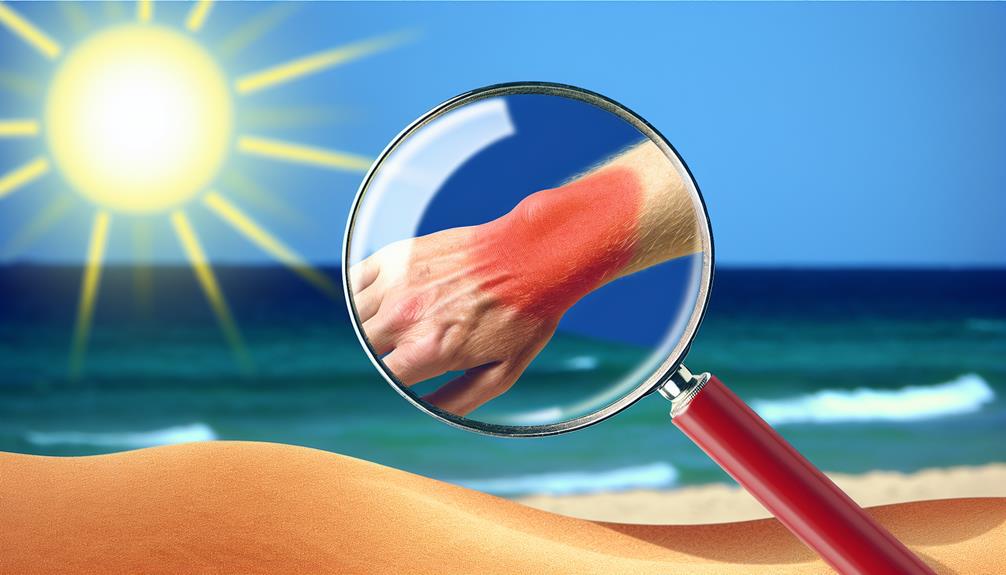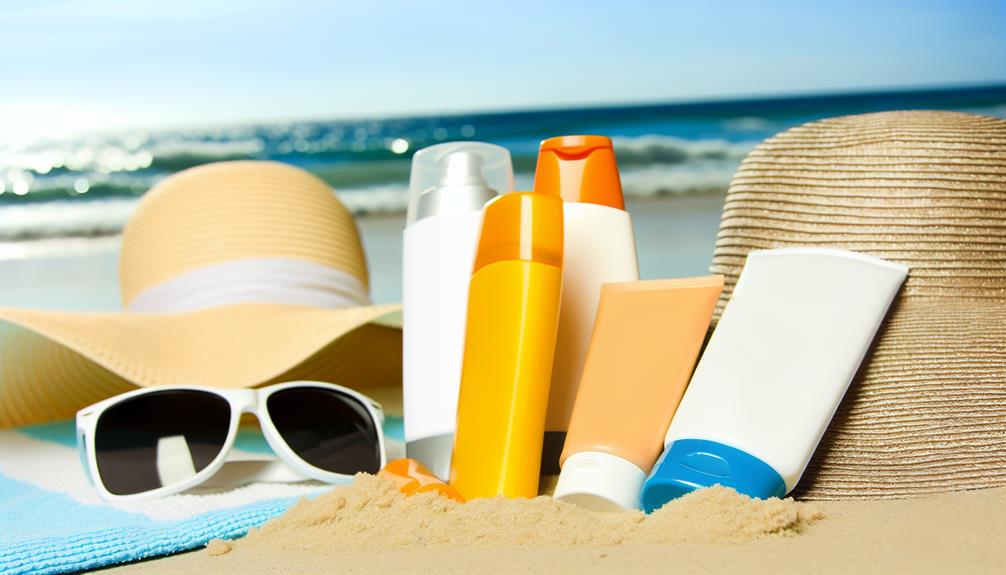


When it comes to protecting your skin from the sun, understanding UVA Vs UVB rays is pivotal. UVA rays penetrate deeply, leading to premature aging, while UVB rays cause surface damage like sunburns and can increase your risk of skin cancer.
Both types of UV radiation contribute to overall skin damage, making it pivotal to choose the right sun protection methods. But how exactly do you decide which sunscreen to use, and what other steps can help minimize UV exposure? Let’s explore the key factors that can help you make informed decisions about your sun safety.
| Feature | UVA Rays | UVB Rays |
|---|---|---|
| Wavelength Range | 320-400 nm | 280-320 nm |
| Penetration Depth | Deeper into the skin (dermis) | Mainly affects the outer layer (epidermis) |
| Skin Aging | Major contributor | Minor contributor |
| Sunburn | Less likely to cause sunburn | Primary cause of sunburn |
| Skin Cancer Risk | Indirectly contributes | Directly contributes |
| Tanning | Causes immediate tanning | Causes delayed tanning |
| Glass Penetration | Can penetrate through window glass | Cannot penetrate through window glass |
| DNA Damage | Causes indirect DNA damage | Causes direct DNA damage |
| Protection | Broad-spectrum sunscreen required | Sunscreen with SPF required |
UV radiation, part of the sun’s light spectrum, greatly influences your skin’s health. When you step outside, you’re exposed to UV radiation, which carries significant dangers. UV radiation dangers aren’t just limited to sunburns; prolonged exposure can lead to severe skin damage, premature aging, and even skin cancer. Every time you’re in the sun, you’re putting your skin at risk.

Sun exposure risks increase with the intensity of UV radiation, which varies throughout the day. The UV Index helps gauge these risks, with higher numbers indicating greater danger. It’s essential to understand that UV radiation can penetrate clouds, meaning you’re still at risk even on overcast days.
The sun emits two primary types of UV rays that affect your skin: UVA Vs UVB Rays. Both types have distinct impacts and pose different risks. UVA rays penetrate deeper, while UVB rays affect the skin’s surface. Both contribute to long-term skin damage and increase your risk of developing skin cancer.
To stay safe, limit your time in the sun, especially during peak hours. Always use sun protection, including broad-spectrum sunscreen, clothing, hats, and sunglasses. By understanding UV radiation, you can better protect your skin from its harmful effects.
Also Read: Mineral Sunscreen: Safer Sun Protection Explained
Penetrating deep into your skin, UVA rays account for 95% of the UV radiation reaching the Earth’s surface. Unlike UVB rays, which affect the outer layers of your skin, UVA rays penetrate more deeply, causing significant sun damage effects. This deep UVA ray penetration can lead to premature aging, including wrinkles and fine lines.
You mightn’t feel their impact immediately, but over time, the damage accumulates, resulting in visible signs of aging and even contributing to skin cancer when combined with UVB exposure.
UVA rays are present throughout the day, regardless of the weather or season, making them a constant threat. They can pass through clouds and even glass, meaning you’re exposed to them indoors and in your car. The sun damage effects from UVA rays also include inflammation and the breakdown of collagen and elastin, which are essential for maintaining your skin’s youthful appearance.
To protect yourself from these insidious rays, it’s essential to use broad-spectrum sunscreen that shields against both UVA and UVB rays. Additionally, consider wearing protective clothing and seeking shade whenever possible to minimize your overall exposure to these harmful rays.
While UVA rays cause aging and penetrate deeply, UVB rays primarily damage the outer layers of your skin, leading to sunburns and increasing your risk of skin cancer. UVB radiation effects are noticeably severe because they directly alter the DNA in your skin cells, causing mutations that can lead to skin cancer over time.

To protect yourself from these harmful effects, proper sunscreen application techniques are essential. First, choose a broad-spectrum sunscreen that offers protection against both UVA and UVB rays. Look for products with at least SPF 30, as recommended by dermatologists.
When applying sunscreen, don’t skimp—use about an ounce (a shot glass full) to cover your entire body. Make sure to apply it 15-30 minutes before going outside to allow it to bind to your skin properly.
Reapplication is key, especially if you’re sweating or swimming. Every two hours is a good rule of thumb. Don’t forget often-missed spots like your ears, back of the neck, and the tops of your feet.
Exposure to UVA and UVB rays leads to various skin issues, ranging from premature aging to severe conditions like skin cancer. UVA rays penetrate deeper into your skin, causing skin aging and inflammation. You might notice wrinkles, fine lines, and a loss of elasticity as these rays break down collagen and elastin over time. Inflammation from UVA exposure can also lead to long-term skin damage, making your skin more prone to conditions like hyperpigmentation.
On the other hand, UVB rays primarily affect the outer layers of your skin, leading to burning and cell mutations. Sunburns are a common result of UVB exposure, causing redness, pain, and sometimes blistering. More concerning, however, are the DNA mutations that UVB rays can induce. These mutations can disrupt normal cell functions and increase your risk of developing skin cancer, including melanoma.
Both UVA and UVB rays contribute to the overall degradation of skin health. While UVA rays accelerate the aging process and cause chronic inflammation, UVB rays result in painful burns and dangerous cell mutations. Understanding these effects underscores the importance of protecting your skin from both types of UV radiation.
Choosing the right sun protection is necessary for safeguarding your skin from harmful UVA and UVB rays. Start with clothing protection, which is your first line of defense. Opt for hats, long sleeves, and pants made from tightly woven fabrics. Look for items labeled with a UPF (Ultraviolet Protection Factor) rating for added security.

Check the UV Index before heading out. A higher UV Index means more intense radiation, so you’ll need extra protection.
Sunscreen is also vital. Choose a broad-spectrum sunscreen to make sure it covers both UVA and UVB rays. Follow SPF guidelines and select a product with at least SPF 30. This level provides significant coverage. Mineral sunscreens are particularly effective; they sit on top of the skin and reflect UV rays, though they might leave a slight white cast.
Sunscreen effectiveness can diminish over time, so reapply every two hours, especially if you’re swimming or sweating. Don’t forget to cover often-missed areas like the ears, the back of your neck, and the tops of your feet.
Combining clothing protection and effective sunscreen use based on SPF guidelines will help you stay safe under the sun.
Also Read: Sunscreen For Your Skin Type: Finding The Perfect Match
Understanding the significance of SPF is crucial for effective sun protection and skin health. SPF, or Sun Protection Factor, measures how well a sunscreen safeguards against UVB rays, which cause sunburn and can lead to skin cancer. Many people think a higher SPF means you can spend more time in the sun without reapplying sunscreen. That’s a common SPF misconception. Regardless of the SPF level, you need to reapply sunscreen every two hours, especially after swimming or sweating.
Choosing an SPF of at least 30 is recommended, as it blocks 97% of UVB rays. Higher SPFs offer slightly more protection but don’t double the coverage. For instance, SPF 50 blocks about 98%, while SPF 100 blocks roughly 99%. The importance of reapplication can’t be emphasized enough; even the highest SPF won’t protect you all day without reapplying.
Another SPF misconception is that it shields you from all UV radiation. SPF primarily guards against UVB rays, so you should select a broad-spectrum sunscreen to protect against both UVA and UVB rays. Always follow the instructions on the sunscreen bottle to guarantee you’re getting the most effective protection.
While selecting the right SPF is essential, opting for mineral sunscreen can offer additional benefits in your sun protection routine. Mineral sunscreens, containing zinc oxide or titanium dioxide, provide a physical barrier that reflects harmful UV rays. This makes them highly effective against both UVA and UVB radiation.

One of the key benefits of mineral sunscreens is their minimal environmental impact. Unlike chemical sunscreens, they don’t contain harmful ingredients like oxybenzone and octinoxate, which are known to damage coral reefs. By choosing mineral sunscreen, you’re protecting both your skin and the planet.
Application techniques are straightforward with mineral sunscreens. They work immediately upon application, so you don’t have to wait before heading outdoors. To maximize effectiveness, make sure to:
In recent years, skin cancer rates have surged, making it more crucial than ever to take proactive measures against UV radiation. To protect yourself, understanding the risks is essential. Both UVA and UVB rays contribute to skin cancer, with UVB being particularly harmful due to its ability to cause DNA mutations. This increases your risk of developing melanoma, the deadliest form of skin cancer.
Melanoma awareness is important because early detection significantly enhances survival rates. Regularly examining your skin for new or changing moles can make a big difference. Some risk factors for melanoma include fair skin, a history of sunburns, excessive UV exposure, and a family history of skin cancer. Knowing these factors helps you understand your vulnerability and take action.
Skin cancer prevention isn’t just about avoiding sunburns but also about minimizing your overall UV exposure. Even on cloudy days, UV radiation can penetrate and damage your skin. By staying informed and vigilant, you can reduce your risk.
Protecting your skin from harmful UV rays is essential to prevent long-term damage and lower your risk of skin cancer. Incorporating effective sun safety practices into your summer skincare routine can make a significant difference.
Here are some practical tips to help you stay guarded:
Also Read: How To Remove Sunscreen From Fabric? – Simple Tips
Understanding the differences between UVA and UVB rays helps you make informed choices about sun protection. Both types of radiation damage your skin, so using a broad-spectrum sunscreen with SPF 30 or higher is essential.
Don’t forget to reapply every two hours, seek shade, and wear protective clothing. These steps reduce your risk of skin cancer and keep your skin healthier. By staying vigilant, you can enjoy the sun while minimizing harmful exposure.